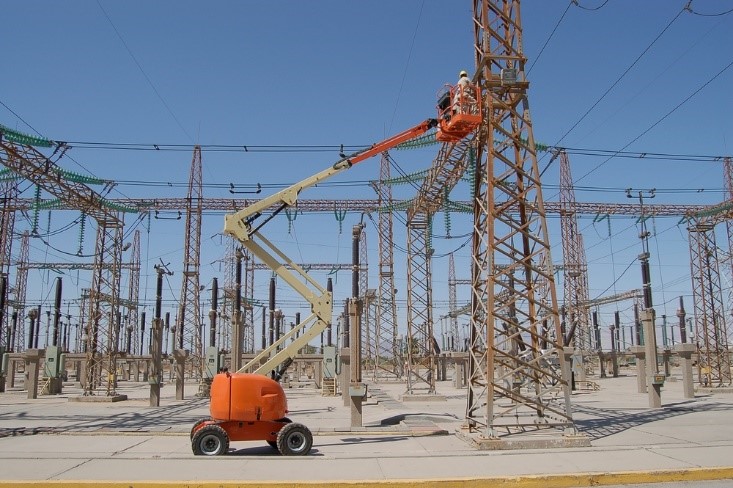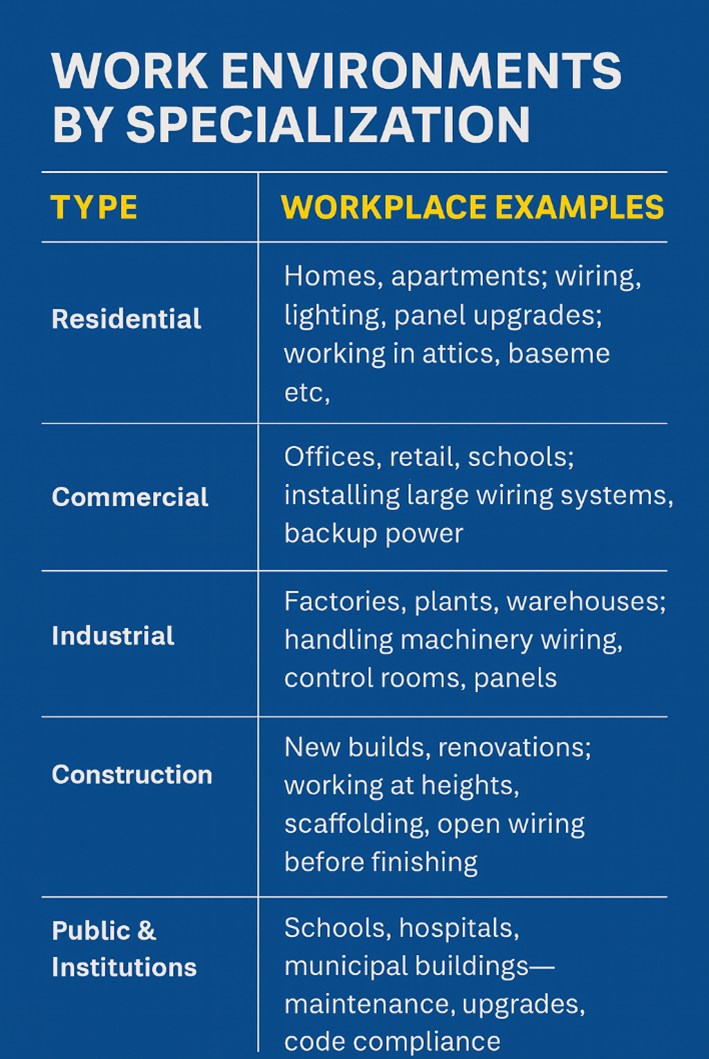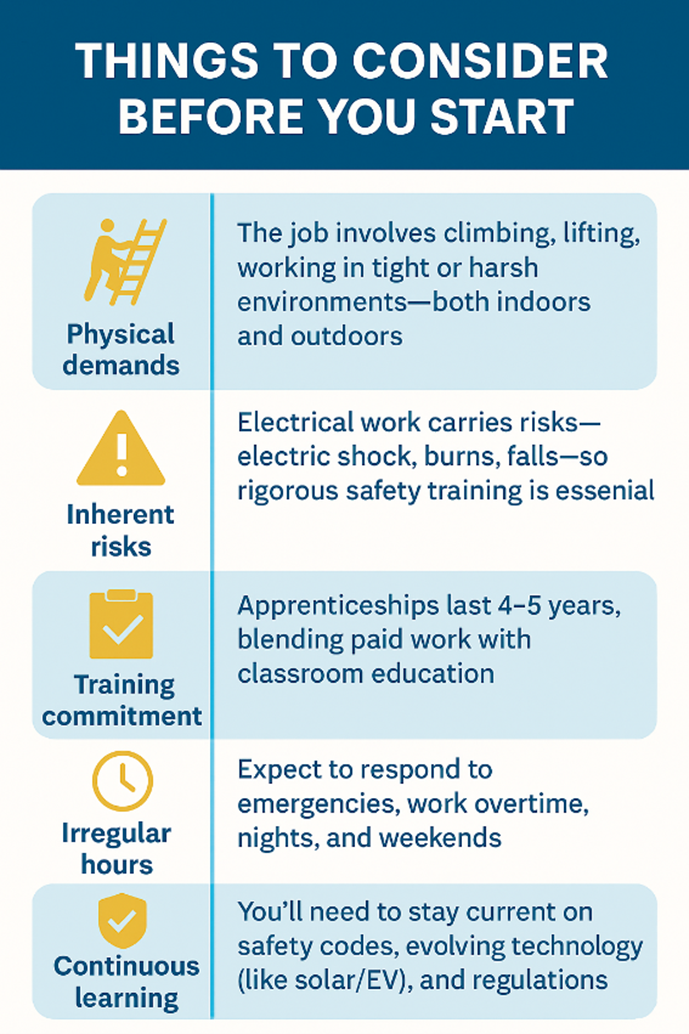
Electricians literally and figuratively light up our lives. Working with both their hands and cutting-edge technologies, these passionate professionals take pride in seeing their efforts lead to reliable power within homes and businesses across the state.
The path to becoming an electrician in California begins with taking relevant coursework and eventually involves getting licensed. Along the way, you can expect to gain a wealth of hands-on experience. To help you prepare for this journey, below we detail California electrician license requirements while revealing: How long does it take to become a licensed electrician?
What Does an Electrician Do?
At its most basic level, being an electrician means working with electrical systems. Specifically, electricians install, maintain and repair these systems, focusing on the safety and functionality of diverse fixtures, wiring and equipment.[i]
No two days look quite alike for the modern electrician, who takes on electrical challenges in many settings.[ii] Typically, however, this role involves the following key elements:
Install, Maintain and Repair
Installation, maintenance and repair make up the bulk of a typical electrician’s workday. Installation involves setting up new systems so that power can run reliably. Maintenance focuses on inspections and other services that boost performance while also extending the lifespan of these electrical systems.
In the event of a malfunction, electricians can diagnose issues and fix wiring or circuits to restore systems to proper functioning. This may call for the replacement of faulty components or rewiring sections to ensure compliance with strict codes.
Blueprints and Technical Diagrams
Electricians rely on resources such as blueprints and technical diagrams to understand how various electrical systems are designed and how components fit into the big picture of these systems.
These blueprints play heavily into planning for installations, pinpointing where wiring should be run and how outlets or switches should be placed. Blueprints also shape troubleshooting efforts, showing how the numerous parts of electrical systems connect and work together. This, in turn, makes it easier to identify and address problems.
Troubleshoot and Diagnose Electrical Issues
Troubleshooting is key to determining why electrical systems no longer work and how issues can be addressed. This may begin with using blueprints to determine how, in an ideal situation, electrical systems would function.
From there, electricians conduct visual inspections to identify various signs of damage, adding multimeters or other diagnostic tools to the mix to gain greater insight into faults. These test results can help reveal the root cause (for example, damaged wires or overloaded circuits).
Ensure Code Compliance and Safety
All electricians must be thoroughly familiar with the National Electrical Code (NEC), along with local building codes and other requirements. These codes shape everything from material selection to load calculations, system grounding and beyond. Code compliance should remain top of mind when performing inspections, with clear documentation verifying that work meets safety standards.
Inspections and Preventive Maintenance
A proactive approach can ensure that electricians catch early problems (like corrosion or loose connections) well before they cause significant damage. Such issues are best detected during regular inspections, which confirm that wiring systems are safe and up to code.[iii]
Preventive maintenance goes beyond visual inspections to include in-depth testing, along with component cleaning or lubrication when needed. This may also involve repairing damaged components or addressing general wear and tear.
Why Should I Become an Electrician?
Working as an electrician can be highly rewarding. Many satisfied electricians appreciate the unique blend of autonomy and tangible problem-solving.[iv] Furthermore, this field offers the potential for job stability and a long-term career.
Real-Life Perspective From Reddit
Reddit has a thriving community of electricians, willing to impart their wisdom while helping aspiring professionals get a strong start in this promising field. In one thread, experienced electricians share the unique perks and challenges of their profession; many point to job stability and wage growth as key advantages. That being said, respondents also reference the physical toll of working as an electrician — yet acknowledging that many skilled trades are far harder on the body.[v]
Experienced electrician Carl Murawski[vi] expands on these ideas, detailing the sense of satisfaction that accompanies completing complex wiring tasks: “There is a huge feeling of satisfaction when you drive by a building you helped wire … Completing an electrical installation is a clear example of seeing the results of your effort.”
Where Do Electricians Work?
Electricians[vii] make a powerful difference in every area of our contemporary lives. Their services are needed across residential, commercial and industrial settings — and in all imaginable geographic locations.[viii] Employers are similarly diverse, with many electricians working for contractors or firms.[ix] Others prefer to carve their own path through self-employment or even by starting a business.
Electrical Contractors and Wiring Installation Firms
Electrical contractors are dedicated companies that manage electrical work across numerous settings. These businesses handle logistics and coordination (including project planning, scheduling and permitting) so that electricians can dedicate more of their focus toward the hands-on elements of installing, maintaining and repairing electrical systems.
Self-Employed or Independent Contractors
Self-employed electricians choose projects that align with their interests and expertise, working directly with businesses or homeowners to tackle essentials such as installing new wiring or repairing damaged systems. These electricians may bid on major projects as contracts or use service agreements to develop steady streams of income.
This approach can be gratifying because it promises greater flexibility and autonomy. However, self-employed electricians may face professional risks, including liability concerns that are more readily avoided when working for a conventional employer. Self-employment can also introduce an element of unpredictability to income and scheduling.
Manufacturing and Industrial Facilities
Many industrial organizations hire electricians directly to keep production lines running smoothly. Electricians in these sectors are expected to understand not only wiring basics but also industrial concepts such as programmable logic controllers. Their efforts can limit downtime to support the continuous operation of complex machinery.
Government Entities and Public Institutions
Government agencies may rely on directly hired electricians to keep public buildings and infrastructure safely and consistently powered. These services are required in all branches of government and at the federal, state and local levels. Electricians may handle:
- Wiring installations
- Maintenance or repairs for municipal buildings
- Schools or transportation hubs
Employment Services or Staffing Agencies
Staffing agencies can be a valuable source of insight when initially stepping into the role of an electrician. These agencies help connect electricians with various companies or projects, offering temporary assignments that can span specializations or niches. This is a great way to gain exposure to multiple settings and work environments.[x] However, agency-based placements should not be confused with working for an electrical contractor, as the latter typically involves a direct-hire setup that is considerably more permanent in nature.

Is a Career as an Electrician Right for Me?
Working as an electrician can be rewarding, though it is not ideal for everyone. Note both the advantages and potential challenges of this field — but also consider how these pros and cons can differ based on your work environment and approach to employment.
Attention to Detail
With electrical systems, even the seemingly smallest details are highly influential. Simply put, being detail-oriented is non-negotiable. These details range from wiring specifications to circuit layouts, equipment ratings and electrical codes. What’s more, electricians must be mindful of specific safety protocols in order to protect themselves and their clients.
Hands-on, Satisfying Work
Many electricians are drawn to this field due to the highly tangible nature of their day-to-day tasks. This is the epitome of a hands-on role, entailing direct work with tools and wiring while building and maintaining intricate systems.
This being said, the very hands-on elements that people find compelling may be precisely what others prefer to avoid. If you’re more drawn to abstract or strictly conceptual tasks, you might not be suited to work as an electrician.
Perseverance and Self-Discipline

Even when working for firms, agencies or other organizations, electricians are quite independent. They take the lead when conducting inspections or troubleshooting systems — and in some cases, these pursuits may be challenging or frustrating. In such situations, it takes considerable perseverance to push through until a solution is found.
Through self-discipline, electricians can meticulously work through problems and maintain focus until they eventually come up with answers that fully resolve diverse electrical issues.
How to Become a Licensed Electrician in California
If, based on the details highlighted above, you feel like a solid fit for working as an electrician, then take the next big step: developing the skills and gaining the credentials needed to thrive in this promising field.
Prepare for an intense training effort encompassing theoretical coursework, hands-on practice and strict licensing requirements that may prove difficult to navigate. At SJVC, we offer a wealth of resources to help you understand how to become a licensed electrician in California. Keep reading to discover what exactly this journey involves:
How Long Does It Take to Become an Electrician?
The path to becoming an electrician can differ from one state to the next and even based on your lifestyle, education or personal preferences. Electrical technology certificate programs can be completed in as few as ten months, but this is followed by apprenticeships or trainee opportunities lasting between three and five years.
Do I Need to Be Licensed and Certified to Become an Electrician?
Licensing and certification play a notable role in electrical technology — providing enhanced confidence and credibility so that employers and clients feel confident in the ability of electricians to safely handle complex installations and repairs.
In general, licensure is needed to work independently. Certifications further improve job prospects and enable electricians to explore specialized opportunities.
Reciprocity for Out-of-State Electricians
Perhaps you’ve already gone through the effort to get licensed and certified outside of California. However, these credentials may not extend across borders, but California does offer reciprocity for journeymen in select states: Arizona, Louisiana and Nevada.[xi]
How Do I Start My Training to Become an Electrician?
Ready to begin becoming an electrician in California? Prepare for a highly structured process that includes several strict requirements regarding training, work experience and registration. To help, we’ve detailed every relevant electrician license California requirement below.
Step 1: Register as an Electrical Trainee
In California, electrical trainees (ETs) can find a variety of job opportunities, including not only apprenticeships but also options involving local electrical contractors.[xii]
Becoming an ET begins with clearing a few basic eligibility requirements. All ETs must be at least 18 years of age and possess high school diplomas or GEDs. Also essential is current enrollment in trade schools or involvement with approved apprenticeship programs.
In California, the pathway of an electrical trainee lends a valuable element of freedom and flexibility to those who hope to eventually pursue self-employment or work with staffing agencies — although some aspiring electricians may prefer the structure and wage progression that accompanies traditional apprenticeships.
Keep in mind that these requirements can vary based on desired types of certification.[xiii] Benchmarks to consider include:
- General Electrician: 8,000 hours
- Residential Electrician: 4,800 hours
- Fire/Life‑Safety & Voice‑Data‑Video: 4,000 hours
- Non‑Residential Lighting: 2,000 hours
Step 2: Complete Technical Training
The California Department of Industrial Relations (CDIR) mandates an annual 150 hours of technical training. This covers diverse concepts such as electrical theory and the National Electrical Code (NEC) but should also encompass hands-on training involving the actual tools and equipment used to install and repair electrical systems.
Step 3: On-the-Job Experience
Technical training is important, but there is no substitute for direct application under supervision. This involves on-the-job experience, which can take one of a few main forms:
Apprenticeship Route
Formal programs, known as apprenticeships, blend theoretical instruction with on-the-job training, where apprentices work under direct supervision. These experiences are strictly monitored by CDIR’s Division of Apprenticeship Standards. Formal wage scales determine how much electrical apprentices earn as they progress through these programs, which may last up to five years.
Trainee Route
As mentioned above, electrical trainees in the state of California enjoy greater freedom compared to apprentices, using a less structured approach to satisfying the state’s licensing requirements. These requirements vary depending on the desired types of certification.[xiv] Consider the following benchmarks:
- General Electrician: 8,000 hours
- Residential Electrician: 4,800 hours
- Fire/Life‑Safety & Voice‑Data‑Video: 4,000 hours
- Non‑Residential Lighting: 2,000 hours
Step 4: Apply and Pass the Certification Exam
California uses challenging exams to confirm that aspiring electricians have the comprehensive knowledge and skills to perform electrical work safely and accurately according to strict state standards.
Prior to taking the test, applicants must complete a comprehensive form that details on-the-job experience and confirms adherence to the requirements mentioned above.[xv]
These are the number of questions and time provided to complete each portion of the exam, as outlined by California’s Department of Industrial Relations.
- General: 270 min / 100 questions
- Residential: 210 min / 80 questions
- Others: 135 min / 50 questions
Step 5: Maintain and Advance
The certification process does not end when you pass the exam. This serves as a starting point, followed by years of continuing education along with frequent license renewals (every three years, to be exact). To qualify for renewal, California electricians must complete at least 32 hours of continuing education and work at least 2,000 hours in the industry within this three-year period.[xvi]
If you plan to bid on large projects, be prepared to obtain your C-10 Electrical Contractor License. This is a crucial next step if you strive to transition from working as an employee to owning your own business.[xvii]
Interested in SJVC’s Electrical Technology Program?
Take the next step toward becoming a licensed electrician in California. SJVC is an excellent starting point, covering essential topics while also providing hands-on training opportunities and guidance via career services. Learn more about our Electrical Technology program today.
Sources:
[i] Zippia. “What does an electrician do?” www.zippia.com/electrician-jobs/what-does-an-electrician-do/
[ii] Indeed. “A Day in the Life of an Electrician.” www.youtube.com/watch?v=lifunadBZ3U
[iii] Larusso, C. “What Is an Electrical Inspection and When Do You Need One?” Angi. www.angi.com/articles/electrical-inspection.htm
[iv] Indeed. “10 Pros and Cons of Being an Electrician (With Tips To Become One).” www.indeed.com/career-advice/finding-a-job/pros-and-cons-of-being-electrician
[v] r/Electricians. “Pros/cons to becoming an electrician.” www.reddit.com/r/electricians/comments/17dpc20/proscons_to_becoming_an_electrician/
[vi] Murawski, C. “20-Year Career as an Electrician – Would I do it again?” Carl Murawski. carlmurawski.com/20-year-career-as-an-electrician-would-i-do-it-again/
[vii] Bureau of Labor Statistics, U.S. Department of Labor, Occupational Outlook Handbook. “Electricians.” www.bls.gov/ooh/construction-and-extraction/electricians.htm
[viii] Bureau of Labor Statistics, U.S. Department of Labor, Occupational Outlook Handbook. “Electricians.” www.bls.gov/ooh/construction-and-extraction/electricians.htm#tab-6
[ix] Bureau of Labor Statistics, U.S. Department of Labor, Occupational Outlook Handbook. “Electricians.” www.bls.gov/ooh/construction-and-extraction/electricians.htm#tab-3
[x] Issitt, M. EBSCO Research Starters. “Electrician.” www.ebsco.com/research-starters/social-sciences-and-humanities/electrician
[xi] California Contractors State License Board. “If You Already Have a Contractors License From Another State or Country.” www.cslb.ca.gov/contractors/journeymen/Journeymen_Reciprocity.aspx
[xii] California Department of Industrial Relations. “Electrician Trainee Guide.” www.dir.ca.gov/dlse/ecu/guide_for_electricians_and_trainees_2-07.pdf
[xiii] California Department of Industrial Relations. “Electrician certification program.” www.dir.ca.gov/dlse/ecu/elecat.html
[xiv] California Department of Industrial Relations. “Electrician certification program.” www.dir.ca.gov/dlse/ecu/elecat.html
[xv] California Department of Industrial Relations. “Application for Electrician Examination and Certification.” www.dir.ca.gov/dlse/ecu/electricalcertificationform.pdf
[xvi] California Department of Industrial Relations, Division of Labor Standards Enforcement. “Electrical certification FAQs.” www.dir.ca.gov/dlse/ecu/ECU_FAQ.htm
[xvii] California Contractors State License Board. “C-10 – Electrical Contractor.” www.cslb.ca.gov/about_us/library/licensing_classifications/Licensing_Classifications_Detail.aspx?Class=C10